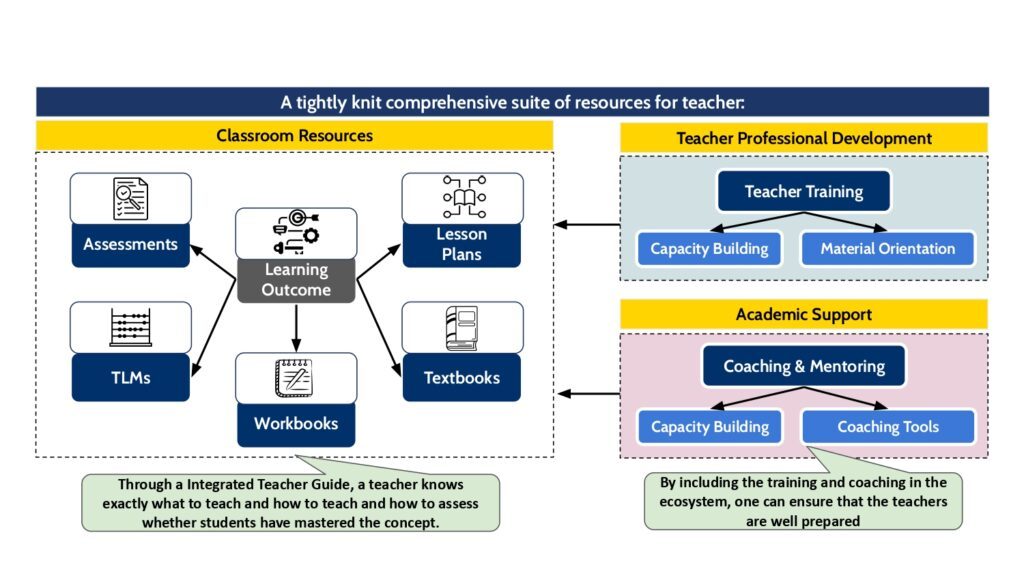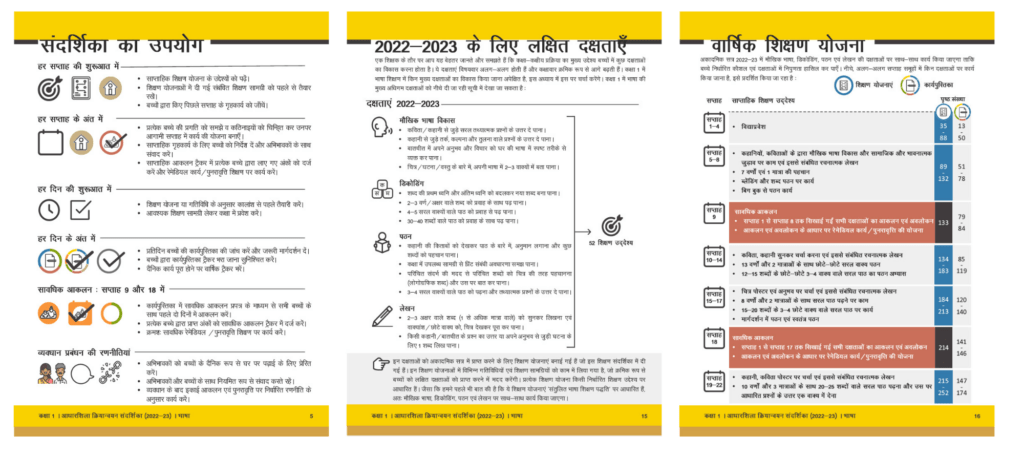 Go Back
Go BackShare
How to design effective FLN Teaching Learning Material (TLM)?
By Anustup Nayak, Harleen Kaur and Sushruti Sachdev
Jan 17, 2023
This article looks at Teaching Learning Material (TLM) as the ‘tool’ to improve student learning in India. It highlights the importance of designing TLMs by following best practices and scientific evidence, which then when coupled with training and ongoing support, can act as an enabler for teachers to succeed in the classroom every day to raise learning outcomes for every child.
Imagine being asked to prepare a Korean meal. You just have a picture of the meal and a kitchen filled with various ingredients. How will you feel in the absence of:
(i) Recipes that specify which ingredients to use when, and how
(ii) Cooking classes that teach Korean cuisine?
That is how most of the teachers feel.
Teachers have multiple responsibilities and are expected to balance complicated socio-emotional classroom interactions, while achieving high cognitive outcomes. The complexity of the job is often accompanied by the lack of support needed to perform the job: absence of quality tools and inadequate pre and in-service training.
The structured pedagogy approach equips teachers with the right techniques, tools, and training, providing them with much-needed support. Research shows that it has the largest and most consistent impact on student learning in low and middle-income countries.

Right tools, also known as Teaching Learning Material (TLM), are a set of classroom resources that assist the teacher in delivering instructions and help students actively engage with learning.
Why do we need the ‘right tools’?
Just 14% of Indian classrooms employ instructional resources other than textbooks. Most textbooks often offer no direction on teaching and might not be developed to satisfy the needs of student learning. This often leads to classrooms where teaching limits to a teacher’s monologue with negligible student participation.
Unfortunately, even in contexts where TLMs exist, unfamiliar content, standardized degrees of difficulty, and no connection to prior school materials reduce their utility.
A well-equipped classroom has both teacher and student-facing material.

High-quality TLM follow key design principles that ensure efficient usage in the classroom.
The 3 Cs of ‘right’ teacher-facing tools: Content, Convenience, and Connection
Effective teacher-facing materials should be a one-stop destination for all the teacher’s needs, thereby reducing their cognitive load. An example of one such tool is teacher guides.
A study by RTI shows greater fidelity to high-quality teachers’ guides enhances the standard of instruction. But what actually goes into making a quality teacher guide?
Content:
i) A scope and sequence of learning that informs the teacher what and when to teach
ii) Structured daily lesson plans with clear, explicit instructions on how to teach
ii) A navigator that tells teachers how to use the teacher Guide

Convenience: You can create the best content based on the scientific principles of pedagogy and research, but teachers will only use it if they find it easier to use than existing alternatives. The format of the teacher guide should make it lightweight and easy to read.


Connection: A teacher embarks on a scavenger hunt each day, trying to stitch multiple disconnected materials like textbooks and student workbooks. A teacher guide should explicitly link all the teacher and student-facing material. Daily learning objectives can act as one such primary key to link the TLM.

The ‘right’ student-facing tools: Facilitating shift from rote memorization to competency-based learning
Learning occurs only when children actively engage in the learning process. Student-facing materials such as workbooks, classroom prints, and math manipulatives make teaching learner-oriented by facilitating student engagement.
A well-designed worksheet provides an opportunity for students to showcase what they have learned and for teachers to identify struggling learners. In order to be effective, worksheets must be:
- Engaging: The content should be familiar to a child’s context to ensure that questions engage students
- Scaffolded: Each worksheet should start with one worked-out example, followed by questions that progress in terms of their difficulty levels.
- Easy to navigate through
- Use of icons
- Dual coded instructions
- Large font

While worksheets serve as proof of learning, the materials listed below enhance student participation during the lesson:
- Classroom print: A print-rich environment in the form of word/ number walls, storybooks, and posters assists in the development of print awareness
- Math manipulatives: A set of Manipulatives helps children ‘see’ abstract mathematical concepts, thereby improving procedural understanding
- Grids & cards: Flashcards and learning grids are effective in acquiring fundamental skills and concepts
- Leveled readers: Leveled readers are usually provided as a series of books— each with a standalone story or informational text with illustrations—and are intentionally targeted at different levels of reading difficulty

These materials should have the following design elements besides the ones suggested for the workbooks above:
- Familiar and inclusive Content: Stories, illustrations, and topics familiar to a child’s context and cultural background and inclusive in nature.
- Easy to source: Can be sourced easily from the environment or locally created by the teacher
- Easy to process Page design: Placing illustrations with the text in readers, using a large font, and limiting the words per sentence/line/page.(See figure 9)

Conclusion
TLM are the ‘tools’ needed to improve learning. However, classrooms today have become a graveyard of multiple, incoherent resources that end up confusing a teacher rather than equipping her to teach better. For TLMs to actually be utilised, it’s important to design them by following the best practices and scientific evidence. Well-designed TLM coupled with training and ongoing support can enable teachers to succeed in the classroom every day to raise learning outcomes for every child.
Keywords
Authored by
Anustup Nayak
Project Director - Early Childhood Education, Central Square Foundation
Harleen Kaur
Project Associate, Classroom Instruction and Practice, Central Square Foundation
Sushruti Sachdev
Senior Project Lead, Classroom Instruction and Practice, Central Square Foundation
Share this on
